Innovations in Speciation Analysis Using HPLC with ICP-MS Detection
Speciation analysis has grown rapidly and has expanded to a variety of markets, including environmental, clinical, food, nutraceutical, and bioanalytical. This growth has resulted from the realization that knowing the total amount of an element does not always provide adequate information for assessing health and environmental effects, but knowing which form of the element is present presents a much more comprehensive picture.

To know which forms of an element are present, they must be separated and detected individually, which is accomplished most easily by separating the species with high performance liquid chromatography (HPLC) and detecting them with inductively couple plasma mass spectrometry (ICP-MS). HPLC requires minimal sample preparation and is an established technique; ICP-MS is very specific and allows a wide dynamic range of concentrations to be measured — nanograms per liter to milligrams per liter. Taken together, the advantages of HPLC–ICP-MS include simple sample preparation, the separating power of HPLC, the low detection capability of ICP-MS, excellent specificity and reproducibility, the ability to monitor multiple isotopes, automated analyses, and total system integration.

Kenneth Neubauer
This column will provide an overview of innovations over the past several years that have improved the HPLC–ICP-MS technique.
A Brief Introduction to Speciation
Speciation is defined as the ability to measure multiple forms of the same element. The various forms can be differences in oxidation state or other atoms associated with the element of interest.
As an example, let's look at arsenic speciation, which is a very popular speciation application. In its simplest form, arsenic exists in two states: As(III) (As+3 ) and As(V) (As+5 ). Both of these forms are toxic, with the As(III) being slightly more toxic than As(V). However, after As is ingested, it undergoes chemical reactions that change its form. In humans, the resulting metabolic species are monomethyl and dimethyl arsenic (MMA and DMA), which serve as tracers to human exposure. When aquatic organisms and plants ingest arsenic, the resulting metabolic species are arsenobetaine (AsB, from fish) and arsenocholine (AsC, from seaweed). These species are nontoxic to humans.
Because humans excrete arsenic in urine, measuring arsenic levels in urine is a good way to monitor a person's exposure: high levels indicate that a person has ingested As. However, elevated levels are not always cause for alarm. If the person has eaten seafood recently, their As level will be high, but because the As species from seafood are nontoxic, there is no need to worry. Speciation analysis of As in urine can distinguish the various forms of As readily.
In this example the sample is a liquid, so the species are separated most easily with HPLC: simply dilute the sample and analyze. ICP-MS is an ideal detection method for As because of its sensitivity and ability to measure low levels.
This example can be extended to a wide variety of sample types, elements, and species, which are measured most easily with HPLC–ICP-MS.
Advances in Column Technology
Chromatographic separations are affected by the interaction of three components: the species, the HPLC mobile phase, and the column stationary phase. Therefore, HPLC method development involves selecting the correct column and mobile phase. Since the early days of HPLC, column technology has advanced significantly.
Early HPLC columns were packed with randomly shaped particles ranging in size from 10 to 20 μm. Because the surface of the packing material interacts with the species and mobile phase components to perform the separation, the more surface area, the greater the separating capability of the column. This has led to the development of smaller, more uniform particles that can provide the same surface area in shorter columns, thus allowing for faster separations without sacrificing resolution. Today, columns packed with 3-μm particles are common and can be used with conventional HPLC pumps. Figure 1 shows a chromatogram of four arsenic species — As(III), As(V), MMA, and DMA — separated in 2 min on a 3-cm column with 3-μm packing material, along with a photo of the column.

Figure 1
Although 3-μm columns work well, columns with even smaller packing material are being developed — down to 1.5 μm. These columns promote faster separations because more surface area is available. However, packing material smaller than 3 μm has some drawbacks. First, because the particles are packed so tightly, the pressure necessary to move liquid through these columns is so high that conventional HPLC pumps cannot be used. Instead, special ultrahigh-pressure pumps are required. Another consideration is that these columns tend to clog faster.
Along with smaller particle sizes, the morphology of the particles has become more consistent: spherical packing materials are common today, as opposed to randomly shaped packing material several years ago. The result is that columns are more reproducible. Thus, the results obtained on one column should be exactly the same as those obtained on another column from the same manufacturer. This is crucial because columns are considered consumables that must be changed over time.
Hardware Innovations: ICP-MS with Cells
Although ICP-MS can measure very low levels, there are significant interferences that result from the plasma or the sample matrix. The most common classes of interferences are argides (matrix + Ar+ → ArMatrix+ ), oxides (matrix + O+ → MatrixOxide+ ), and isobaric overlap (two elements having the same isotopic mass). Luckily, these interferences are easily predicted with knowledge of the sample matrix.
With HPLC–ICP-MS, these interferences are especially easy to predict because the "sample matrix" is really the LC mobile phase — as seen by the ICP-MS system. Typical flow rates used in HPLC are 0.2–1.5 mL/min, so the mobile phase composition will produce interferences; the actual sample matrix has very little effect on the plasma. Think about it: typical injection volumes in HPLC–ICP-MS range from 20 to 100 μL. This volume is injected into a flowing stream of approximately 1 mL/min and spread out over several minutes. Therefore, the matrix from the sample is diluted significantly by the time it reaches the plasma. As a result, the sample matrix will have almost no impact on the resulting ions.
However, interfering species from the mobile phase could be a problem. To solve the interference issues, ICP-MS instruments with collision and reaction cells have been developed. These instruments remove interferences through collisions and reactions with a gas that is introduced in the ion path. By careful selection of the cell properties, interferences are eliminated. An important consideration with cell instruments is that the effects of the interferences must be removed without losing so much analyte sensitivity that the analyte cannot be measured at the desired levels. This is especially important for speciation analysis because the concentrations of the individual species are less than the total concentration.
Between the HPLC and ICP-MS Systems: The Switching Valve
Although interfacing an HPLC system with an ICP-MS system is simple, a characteristic of HPLC that is not amenable to ICP-MS is total dissolved solids (TDS). The mobile phase of most HPLC separations contains high levels of TDS in the form of salts, which are necessary for the separation. Typically, TDS concentrations in the mobile phase range from 500 to 1000 mg/L — or higher. Combined with the flow rates of HPLC (0.5–1.5 mL/min) and the long chromatograms (2–30 min, or longer), a large quantity of solids enter the ICP-MS system during a typical analysis. The salt level is even higher when considering that columns must be equilibrated with mobile phase for 20–60 min before the first injection or analysis.
Salts are a problem for ICP-MS because they can deposit within the spectrometer, most commonly on the interface cones and ion lenses. Any salt that is not ionized by the plasma has the potential to deposit, leading to signal drift and the possibility of clogged cones.
One way to minimize the quantity of salts entering the ICP-MS system is through the use of an automated switching valve between the HPLC and the ICP-MS: while the HPLC system is equilibrating, mobile phase is directed to waste. When an analysis is started, the valve automatically switches the LC flow to the ICP-MS instrument. After an analysis is complete, the valve will again divert the LC flow to waste.
This is especially important for runs that will end when no one is in the laboratory. Mobile phase should not be allowed to sit stagnant on the column or precipitation can occur, ruining the column. Therefore, washing the column after a run is recommended, as well as keeping a low flow of mobile phase going to prevent precipitation. Either of these options is best done with the flow going to waste rather than depositing in the ICP-MS system. Automating the actions of the switching valve means one less thing the operator has to worry about.
Software
From the previous discussion, it can be imagined that performing speciation can be complicated: the HPLC and ICP-MS systems and switching valve all must be controlled and coordinated. Then the data must be collected, processed, and fed into reports. Accomplishing these tasks typically requires two or three software programs.
However, software has been developed that performs all of these functions in one program and does everything automatically: the user simply defines the HPLC and ICP-MS method parameters, places the samples in the autosampler, fills in the sample list, and starts the analysis. After initially setting the peak detection parameters (usually on the first calibration standard), data is collected, processed, and fed into reports. When an analysis is complete, the column is cleaned and the system shuts down. As a result, speciation analyses have been simplified — and further advances in speciation software are expected.
Multiple Isotopes: Simultaneous Multielement Speciation
A characteristic of ICP-MS is its ability to measure multiple isotopes of multiple elements during an analysis. In fact, most ICP-MS analyses involve measuring multiple elements. However, most HPLC analyses typically look at one element at a time, thereby not leveraging the multielement capability of ICP-MS. The reason is that different elements usually require different sets of HPLC conditions to separate various species. As a result, the LC conditions that could vary by element and species include the mobile phase, column, and LC pump program. Therefore, to perform speciation of different elements in the same sample, multiple injections must be made under different LC conditions: one for each element.
To perform multielement speciation from a single injection, a common set of HPLC and ICP-MS conditions must be found to separate and detect the desired species of the desired element. Finding common ICP-MS conditions is simple: this is how normal ICP-MS analyses (that is, without HPLC) are performed. Finding common HPLC conditions is the difficult part of the process.
However, using ICP-MS as a detector helps simplify this process because multiple isotopes are monitored and a complete separation of all species from all isotopes does not have to be achieved.
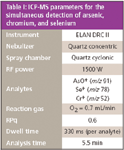
Table I: ICP-MS parameters for the simultaneous detection of arsenic, chromium, and selenium
For example, let's look at the simultaneous speciation of arsenic, chromium, and selenium, focusing on species that are commonly found in environmental waters: As(III), As(V), Cr(III), Cr(VI), Se(IV), Se(VI), and SeCN. First, let's establish the ICP-MS conditions since these are the easiest. Chromium has a large carbon interference on its main isotope (m/z 52). Although minor isotopes are available, chromium levels are usually low, so the main isotope should be used. Therefore, conditions can be found using cell-based ICP-MS that will remove the interference but maintain sensitivity for Cr. Likewise, these same cell conditions can be applied to arsenic and selenium so that interferences are removed. Table I shows the ICP-MS parameters.

Table II: HPLC parameters for the simultaneous separation of As(III), As(V), Cr(III), Cr(VI), Se(IV), Se(VI), and SeCN
Next, the HPLC conditions must be established. This involves HPLC method development, which can be quite time consuming because there are so many interactions that must be monitored between each species of each element with the mobile phase and column stationary phase. However, Table II shows HPLC conditions that were found to separate the desired species.
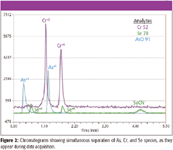
Figure 2
Combining the conditions in Tables I and II yields the chromatograms shown in Figure 2. Note that all species of each element are separated. Figure 2 shows how the chromatograms appear as they are being acquired; Figure 3 shows a different, simplified view of each element. Note how the peaks for Cr(III) and As(V) are not completely resolved, while those of Cr(VI) and Se(VI) have the same retention times. However, because different isotopes are being monitored, complete separation of all species for all isotopes does not have to be established; only separation of species for a given element is required. Figure 4 shows the As, Cr, and Se chromatograms of a bottled water sample acquired under the same conditions.
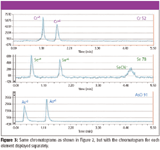
Figure 3
Having the ability to perform speciation of multiple elements from a single injection saves a significant amount of time versus analyzing one element at a time. Likewise, having the ability to monitor multiple isotopes also means that complete separation of all species does not need to be attained. From an HPLC perspective, the advantages of ICP-MS as a detector are unique and save a considerable amount of time, both in method development and analyses.
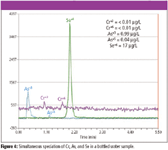
Figure 4
Multiple Isotopes: Species Confirmation
Another unique characteristic of ICP-MS as an HPLC detector is in its ability to use multiple isotopes to help identify an unknown peak. The only way to identify a peak in a sample is by matching its retention time with that of a known standard: if the retention times match, then the identity of the peak is known. However, if the retention times do not match, the peak could be another species of the same element, an interference, or a shift of the retention time in the peak of interest, the result of a chromatographic interference.
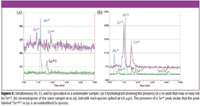
Figure 5
One tactic to use when trying to identify an unidentified peak is to spike the sample with standards of known species. If the unknown peak gets bigger, then it is a known species with a matrix-induced retention time shift. If the peak remains constant, then it is probably another species of the same element. Figure 5 shows an example of this for simultaneous As-Cr-Se speciation. Figure 5a shows a chromatogram of an industrial wastewater sample. The peak labeled "Se+6 ?" has an elution time close to that of the Se(VI) standard, but not exactly. This suggests that the peak is probably Se(VI), but with a matrix-induced shift. To confirm, the sample was spiked with standards from all the species; Figure 5b shows the resulting chromatograms. As is evident, all peaks became larger — except the unknown peak near Se(VI). The peak labeled Se(VI) now matches the retention time of that in the standard. This means that the peak labeled "Se+6 ?" in the original chromatogram is not Se(VI), but most likely another Se species.
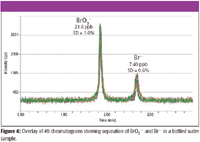
Figure 6
An example of a case in which using multiple isotopes distinguishes unknown peaks from interferences is seen in bromine speciation. Figure 6 shows chromatograms of bromate (BrO3–) and bromide (Br–) in a water sample, monitored at 79 Br. In this figure, 49 chromatograms are overlaid to demonstrate robustness of the method. Figure 7a shows the 79 Br chromatogram of another water sample. In this case, there are six peaks, but only two match the retention times of bromate and bromide. It's not known whether the other peaks are other bromine-containing species or interferences.
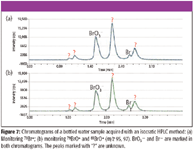
Figure 7
Luckily, bromine has a second isotope at m/z 81. Unfortunately, a large plasma-based interference makes 81 Br unusable. However, through the use of a cell-based ICP-MS, bromine can be moved and analyzed as its oxide at both m/z 95 and 97 (79 BrO–, 81 BrO– ). Figure 7b shows the chromatograms at these masses. Because the same peaks appear at the same retention times at three masses, it is reasonably certain that the unidentified peaks are really bromine-containing species and not interferences.
Further confirmation that the unidentified peaks are bromine-containing species was made by analyzing the sample with a different separation scheme. The resulting chromatograms appear in Figures 8a and 8b. Again all peaks match, although a new peak is now seen. Because two separation schemes using three masses all show the same peaks, it can be stated with a high degree of certainty that the unidentified peaks really contain bromine and are not interferences.
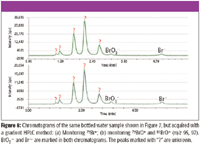
Figure 8
Conclusions
It has been shown that hardware, software, and method development innovations have made speciation analyses by HPLC–ICP-MS easier and more productive. From a spectroscopist's point of view, short HPLC columns with small particles have opened the pathway to rapid analyses, more on the time-scale with typical ICP-MS analyses. The use of HPLC allows for simple sample preparation and the ability to separate elements into their species, thus providing more information than total analysis.
From a chromatographer's viewpoint, using ICP-MS as a detector offers a variety of unique characteristics, with the ability to monitor multiple isotopes being the most important: now species can be confirmed and multiple elements can be separated and detected from a single injection.
The development of software specifically for speciation analysis has simplified analyses, while the use of an automated switching valve is beneficial for the long-term performance of the ICP-MS system. Additionally, the development of cell-based ICP-MS has allowed lower levels of species to be measured accurately.
Taken together, all of these innovations have contributed to the rapid growth of speciation analysis by HPLC–ICP-MS.
Kenneth Neubauer is a Senior Scientist at PerkinElmer LAS, where he works with both ICP-MS and HPLC/ICP-MS. He received a BA in Chemistry from Colgate University and a Ph.D. in Analytical Chemistry from the University of Delaware. Ken joined PerkinElmer in 1997.
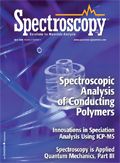
High-Speed Laser MS for Precise, Prep-Free Environmental Particle Tracking
April 21st 2025Scientists at Oak Ridge National Laboratory have demonstrated that a fast, laser-based mass spectrometry method—LA-ICP-TOF-MS—can accurately detect and identify airborne environmental particles, including toxic metal particles like ruthenium, without the need for complex sample preparation. The work offers a breakthrough in rapid, high-resolution analysis of environmental pollutants.
Applications of Micro X-Ray Fluorescence Spectroscopy in Food and Agricultural Products
January 25th 2025In recent years, advances in X-ray optics and detectors have enabled the commercialization of laboratory μXRF spectrometers with spot sizes of ~3 to 30 μm that are suitable for routine imaging of element localization, which was previously only available with scanning electron microscopy (SEM-EDS). This new technique opens a variety of new μXRF applications in the food and agricultural sciences, which have the potential to provide researchers with valuable data that can enhance food safety, improve product consistency, and refine our understanding of the mechanisms of elemental uptake and homeostasis in agricultural crops. This month’s column takes a more detailed look at some of those application areas.
Trending on Spectroscopy: The Top Content of 2024
December 30th 2024In 2024, we launched multiple content series, covered major conferences, presented two awards, and continued our monthly Analytically Speaking episodes. Below, you'll find a selection of the most popular content from Spectroscopy over the past year.